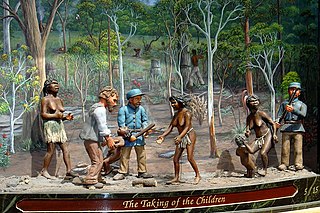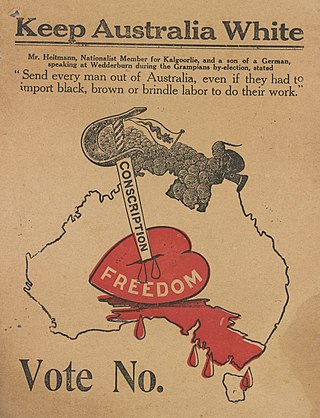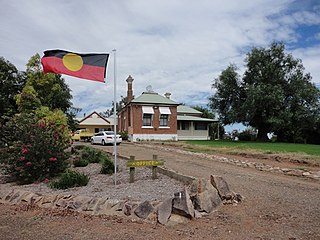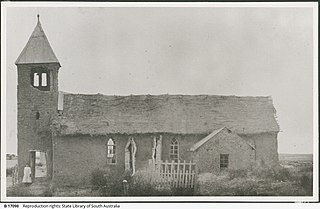Related Research Articles

The Stolen Generations were the children of Australian Aboriginal and Torres Strait Islander descent who were removed from their families by the Australian federal and state government agencies and church missions, under acts of their respective parliaments. The removals of those referred to as "half-caste" children were conducted in the period between approximately 1905 and 1967, although in some places mixed-race children were still being taken into the 1970s.
Warburton,Warburton Ranges or Milyirrtjarra is an Aboriginal Australian community in Western Australia, just to the south of the Gibson Desert and located on the Great Central Road and Gunbarrel Highway. At the 2016 census, Warburton had a population of 576.
Aboriginal Protection Board, also known as Aborigines Protection Board, Board for the Protection of Aborigines, Aborigines Welfare Board, and similar names, refers to a number of historical Australian state-run institutions with the function of regulating the lives of Aboriginal Australians. They were also responsible for administering the various half-caste acts where these existed and had a key role in the Stolen Generations. The boards had nearly ultimate control over Aboriginal people's lives.

nat
Rodolphe Samuel Schenk was an Australian missionary.
Charles Duguid was a Scottish-born medical practitioner, social reformer, Presbyterian lay leader and Aboriginal rights campaigner who lived in Adelaide, South Australia for most of his adult life, and recorded his experience working among the Aboriginal Australians in a number of books. He founded the Ernabella mission station in the far north of South Australia. The Pitjantjatjara people gave him the honorific Tjilpi, meaning "respected old man". He and his wife Phyllis Duguid, also an Aboriginal rights campaigner as well as women's rights activist, led much of the work on improving the lives of Aboriginal people in South Australia in the mid-twentieth century.

Racism in Australia comprises negative attitudes and views on race or ethnicity which are held by various people and groups in Australia, and have been reflected in discriminatory laws, practices and actions at various times in the history of Australia against racial or ethnic groups.
Point Pearce, also spelt Point Pierce in the past, is a town in the Australian state of South Australia. The town is located in the Yorke Peninsula Council local government area, 194 kilometres (121 mi) north-west of the state capital, Adelaide.
An Aboriginal reserve, also called simply reserve, was a government-sanctioned settlement for Aboriginal Australians, created under various state and federal legislation. Along with missions and other institutions, they were used from the 19th century to the 1960s to keep Aboriginal people separate from the white Australian population. The governments passed laws related to such reserves that gave them much power over all aspects of Aboriginal people’s lives.

The Cootamundra Domestic Training Home for Aboriginal Girls, commonly known as "Bimbadeen" and Cootamundra Girls' Home, located at Cootamundra, New South Wales, was a home and training college for Aboriginal girls during the 20th century. It operated by the NSW Government's Aborigines Welfare Board from 1911 to 1968 to provide training to girls forcibly taken from their families under the Aborigines Protection Act 1909. The only training received by the girls was to work as domestic servants, and they were not allowed any contact with their families. They were part of a cohort of Aboriginal people now known as the Stolen Generations.

Raukkan is an Australian Aboriginal community situated on the south-eastern shore of Lake Alexandrina in the locality of Narrung, 80 kilometres (50 mi) southeast of the centre of South Australia's capital, Adelaide. Raukkan is "regarded as the home and heartland of Ngarrindjeri country."
Koonibba is a locality and an associated Aboriginal community in South Australia located about 586 kilometres (364 mi) northwest of the state capital of Adelaide and about 38 km (24 mi) northwest of the municipal seat in Ceduna and 5 km (3.1 mi) north of the Eyre Highway.
The Aboriginal South Australians are the Indigenous people who lived in South Australia prior to the British colonisation of South Australia, and their descendants and their ancestors. There are difficulties in identifying the names, territorial boundaries, and language groups of the Aboriginal peoples of South Australia, including poor record-keeping and deliberate obfuscation, so only a rough approximation can be given here.
Colebrook Home was a South Australian institution for Australian Aboriginal children run by the United Aborigines Mission from 1924 to 1981, existing at four different locations over its lifetime.

Killalpaninna Mission, also known as just Killalpaninna, or alternatively Bethesda Mission, or alternatively Kopperamanna, was a Lutheran mission for Aboriginal people in northeast South Australia, whose site is now located in the locality of Etadunna. It existed from 1866 to 1915.

Maloga Aboriginal Mission Station also known as Maloga Mission or Mologa Mission was established about 15 miles (24 km) from the township of Moama, on the banks of the Murray River in New South Wales, Australia. It was on the edge of an extensive forest reserve. Maloga Mission was a private venture established by Daniel Matthews, a Christian missionary and school teacher, and his brother William. The mission station operated intermittently in 1874, becoming permanent in 1876. The Mission closed in 1888, after dissatisfied residents moved about 5 miles (8 km) upriver to Cummeragunja Reserve, with all of the buildings being re-built there.

Bomaderry Aboriginal Children's Home is a heritage-listed former Institutional home for Aboriginal children and now Nowra Local Aboriginal Land Council offices at 59 Beinda Street, Bomaderry, in the South Coast region of New South Wales, Australia. It was designed by United Aborigines Mission and built from 1908. It was also known as Bomaderry Children's Home; Bomaderry Babies Home; and United Aborigines Mission Home. The property is owned by Nowra Local Aboriginal Land Council. It was added to the New South Wales State Heritage Register on 17 February 2012.
The La Perouse Mission Church is a heritage-listed former church building and now vacant building and unused church located at 46 Adina Avenue, La Perouse, City of Randwick, New South Wales, Australia. It was built from 1894 to 1930. It is also known as Colebrook Memorial Aboriginal Evangelical Church. The property is owned by La Perouse Local Aboriginal Land Council. It was added to the New South Wales State Heritage Register on 15 March 2013.
Australian Indigenous Ministries, formerly Aborigines Inland Mission of Australia, is an interdenominational Christian organisation that provides ministries to Aboriginal Australians. Aborigines Inland Mission of Australia was established in 1905, and ran many Aboriginal missions across Australia, including the Retta Dixon Home in Darwin, Northern Territory, St Clair Mission in Singleton, New South Wales.
References
- ↑ "United Aborigines Mission". trove.nla.gov.au. National Library of Australia. Retrieved 29 June 2019.
- ↑ "United Aborigines Mission - Organisation - Find & Connect - South Australia". www.findandconnect.gov.au. Retrieved 13 May 2017.
- ↑ United Aborigines Mission (1994), Challenging the Almighty : 100 years of trusting God in the work of the United Aborigines Mission, United Aborigines Mission, ISBN 978-0-949181-10-7
- 1 2 "Human Rights and Equal Opportunity Commission Report 'Bringing them Home' (Chapter Eight)". Australian Human Rights Commission. April 1997. Retrieved 28 June 2019.